Abstract
In recent years, new surgical techniques have been developed to improve the quality of operations, reduce the risk to patients and reduce the pain experienced by patients. Prominent developments include minimally invasive surgery, robot-assisted hip operations, computer-assisted surgery (CAS) and virtual reality (VR). These developments have helped surgeons operate under difficult visual conditions.
Rapid prototyping (RP) technology has also found applications in medicine. The RP technique is able to fabricate a representative, physical 3D model. This 3D model can enhance interpretation, visual and physical evaluation, and the rehearsal and planning of the surgical steps before a surgical operation is carried out in order to eradicate the trauma. This paper presents the procedures involved in the conversion of computerised tomography (CT) scan data to a useful physical model. A case study of a CT scanned file of a patient who had an injury to the right eye socket is presented. Three different RP systems (SLA, SGC and LOM) are benchmarked for comparison in terms of the surface finish, accuracies, visual appearance and processing speed.
Because of the ability of RP to fabricate models that are complex in design with intricate features that may be hidden by undercuts, as demonstrated in this paper, the results of this research can be extended to applications in general engineering. One specific area of application would be reverse engineering.
Similar content being viewed by others
References
A. J. Lightman, B. Vanassche, P. D'Urso and Y. Shinjiro, “Applications of rapid prototyping to surgical planning: a survey of global activities”, Proceedings of the 6th International Conference on Rapid Prototyping, 4–7 June 1995, pp. 43–49, 1995.
B. Swaelens and J. P. Kruth, “Medical applications of rapid prototyping techniques”, Proceedings of the 4th International Conference on Rapid Prototyping, 14–17 June 1993, pp. 107–120, 1993.
C. K. Chua, “Three-dimensional rapid prototyping technologies and key development areas”, Computing and Control Engineering Journal, 5(4), pp. 200–204, August 1994.
C. K. Chua and K. F. Leong, “Rapid prototyping: principles and application in manufacturing”, John Wiley April 1997.
M. L. Rhodes and D. D. Robertson, “Computers in surgery and therapeutic procedures”, IEEE Computer Applications in Surgery, pp. 20–23, January 1996.
M. Mahoney and P. Diana, “Rapid prototyping in medicine”, Computer Graphics World, 18(2), pp. 42–48, February 1995.
A. L. Jacob, B. Hammer, G. Niegel, T. Lambreeht, H. Schiel, W. Steinbrich and M. Hunzicker. “First experience in the use of stereolithography in medicine”, Proceedings of the 4th International Conference on Rapid Prototyping, 14–17 June 1993, pp. 121–134, 1993.
J. Adachi, T. Hara, N. Kusu and H. Chiyokura, “Surgical simulation using rapid prototyping”, Proceedings of the 4th International Conference on Rapid Prototyping, 14–17 June 1993, pp. 35–142, 1993.
J. S. Bill, J. F. Renther, W. Dittmann, N. Kubler, J. L. Meier, H. Pistner and G. Wittenbery, “Stereolithography in oral and maxillofacial operation planning”, International Journal of Oral and Maxillofacial Surgery, 24, pp. 98–103, November 1995.
T. Kaneko, M. Kobayashi, Y. Tsuchiya, T. Fujino, M. Itoh, M. Inomata, M. Uesugi, K. Kawashima, T. Tanijiri and N. Hasegawa, “Free surface 3-dimensional shape measurement system and its application to Mictotia ear reconstruction”, The Inaugural Congress of the International Society for Simulation Surgery, 1992.
Author information
Authors and Affiliations
Additional information
An erratum to this article is available at http://dx.doi.org/10.1007/s00170-016-9122-2.
Rights and permissions
About this article
Cite this article
Chua, C.K., Chou, S.M., Lin, S.C. et al. Rapid prototyping assisted surgery planning. Int J Adv Manuf Technol 14, 624–630 (1998). https://doi.org/10.1007/BF01192281
Published:
Issue Date:
DOI: https://doi.org/10.1007/BF01192281
